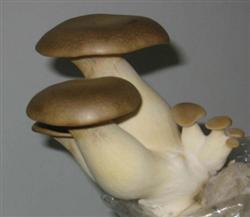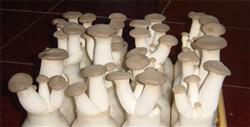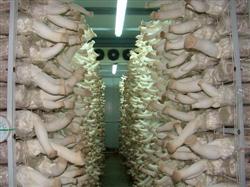How to cultivate Pleurotus eryngii twice a year

How to grow mushrooms twice a year? Please guide Pleurotus eryngii, mainly edible mushroom stem, because of its fresh taste, pleasant almond flavor and greatly favored by the market, it is understood that in recent years the market has been in short supply situation, and seasonal sales price is very high, production and management benefits are very considerable, is one of the key development varieties of edible fungi. Pleurotus eryngii varieties can be divided into two types of strains, one is bowling ball shape, its fruiting body shape is the base of the stipe expanded, tapering upward, the top cap is small, only the diameter of the stipe joint is slightly open, generally about 0.3~0.8 cm; the other is cylindrical mushroom, that is, the thickness of the stipe is basically the same, the cap is also small. The former has good shape, white color and high value, but its biological efficiency is low, the biological efficiency of general commercial production is about 40~60%, the latter has higher mushroom yield, the biological efficiency is generally above 80%, and the high one can exceed 120%. However, due to the lack of understanding of its biological characteristics, the commercial mushroom rate is not high, which makes it difficult to obtain ideal production benefits. According to our research, the tactics of "three steps" in management can guarantee the production effect to the greatest extent: the first step: the comprehensive balance of base material nutrition is the foundation. The phenomenon of uneven fruiting and low yield in production is directly related to insufficient nutrition and unbalanced nutrition of base material. Can be very clear to inform the majority of mushroom farmers friends: practice has proved that even if the use of cottonseed hull as a base material, but also lack a large number of nutrients, must be artificially prepared, supplemented, in order to make hyphae have sufficient nutritional support, in order to improve the vitality of hyphae (decomposition ability), in order to ensure the yield of mushrooms. The basic formula is as follows: 150kg of cottonseed hull, 70kg of sawdust, 30kg of wheat bran, 5kg of bean cake powder, 5kg of calcium superphosphate, 5kg of gypsum powder, 1kg of lime powder, 0.75kg of urea, 1kg of sucrose and 1 bag of edible mushroom three-dimensional nutrient essence (mixing type). or sawdust 150kg, cottonseed hull, wheat bran 45kg each, corn (2338,-1.00,-0.04%) powder 10kg, bean cake powder 5kg, calcium superphosphate 6kg, gypsum powder, lime powder 1.5kg each, urea 1kg, edible mushroom three-dimensional nutrient essence 1 - 2 bags. Note: the lime powder in the formula is mixed with sawdust and wheat bran after adding water. After 2 days of stacking, mix well with other raw materials and accessories. Finally, add three-dimensional nutrients of edible fungi. Bagging, sterilization, inoculation, etc. are routine. Step 2: The full ripening of hyphae is completely guaranteed. It was found that although Pleurotus eryngii did not need a long post-ripening period of Pleurotus nebrodensis, it was an important guarantee that the mushroom was neat and uniform in size by adjusting the temperature to make it fully ripened, completely ripened and ripened uniformly after the completion of fungus development. The basic operation is as follows: after all the bags are full of bacteria, try to control the temperature to keep it below 20℃, or about 12℃ if conditions permit, so that the mycelium can develop horizontally at low temperature. After about 10~20 days, the mycelium is obviously thicker and stronger than the original, laying a foundation for improving its decomposition ability. Then, raise the temperature to more than 25℃, not more than 33℃, so that the mycelium is in an active period again, fully absorb and transform the nutrients of the base material, and then increase the amount of mycelium, that is, accumulate biological energy, and lay a good material foundation for the next step of fruiting, which takes about 10 days. Step 3: timely and proper bud management is the condition. Pleurotus eryngii bud thinning is a technical link missed by most mushroom farmers, which is an important condition to ensure high quality and high yield. If it is properly operated, the commodity rate of mushroom products can be increased to more than 95%. The bud thinning operation is very simple: first, prepare a wallpaper knife, or grind it into a sharp knife with a hacksaw; secondly, select dense young buds at the mushroom bud generation point, make sure to keep 2~3 young buds on each mushroom surface, and cut off the bud tips of the rest of the mushroom buds with a sharp knife. However, two points should be noted: one is to retain the mushroom buds, the spacing should be appropriate, in order to avoid crowding after growing up, the other is not to hurt the reserved buds when thinning the buds. Finally, after finishing the bud thinning operation, spray 800 times solution of eliminating all diseases to the wall, ground, vent and other places in the shed in time, and spray 1500 times mushroom killing solution to the space of mushroom shed, so as to prevent the wound of bud thinning from being infected with virus bacteria. During the growth of fruit bodies, the temperature of shed was kept at 15℃, humidity of shed was 85~95%, fresh ventilation and weak scattered light were kept. The rest can be managed as usual. Click for more cultivation techniques of Pleurotus eryngii Click for more cultivation techniques of edible fungi
- Prev

How to cultivate Pleurotus eryngii
How to cultivate Pleurotus eryngii? Please introduce in detail the cultivation methods of Pleurotus eryngii can refer to the following cultivation methods: ㈠ cultivation raw materials are suitable for the growth of Pleurotus eryngii, such as sawdust, cotton husk, corncob, bagasse, bean straw and so on.
- Next

How to cultivate Pleurotus eryngii in cold room
How to cultivate Pleurotus eryngii in cold room? Please introduce the cold room cultivation of out-of-season Pleurotus eryngii can refer to the following methods: 1, cold room construction of cold room should choose the sunny flat ground with higher topography, close to the water source and good drainage. Generally, each cold room is 10m long, 6m wide and 4m high, and the cold room should not be too large, otherwise it is difficult.
Related
- Fuxing push coffee new agricultural production and marketing class: lack of small-scale processing plants
- Jujube rice field leisure farm deep ploughing Yilan for five years to create a space for organic food and play
- Nongyu Farm-A trial of organic papaya for brave women with advanced technology
- Four points for attention in the prevention and control of diseases and insect pests of edible fungi
- How to add nutrient solution to Edible Fungi
- Is there any good way to control edible fungus mites?
- Open Inoculation Technology of Edible Fungi
- Is there any clever way to use fertilizer for edible fungus in winter?
- What agents are used to kill the pathogens of edible fungi in the mushroom shed?
- Rapid drying of Edible Fungi

